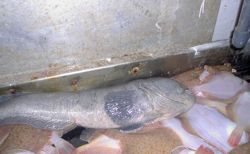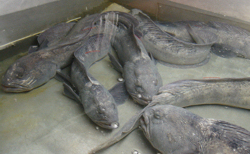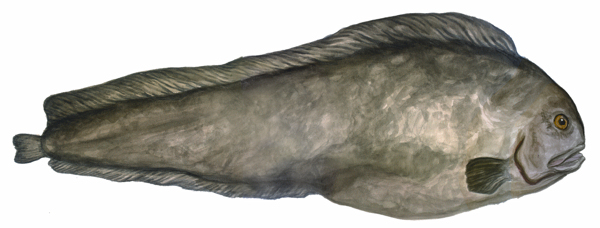Tips for handling and releasing Wolffish
The Species at Risk Act
Two of the three wolffish species found in waters off Atlantic Canada are at risk of becoming extinct. The third species is of Special Concern.
A new Canadian Species at Risk Act protects those species. This new law was created to prevent wildlife species from becoming extinct, but no single group or organization can ensure the recovery of a species. We all have a part to play.
Wolffish are incidentally caught in some of the most common fishing gears used throughout Atlantic Canada. Proper handling and quick release of wolffish back into the water improves their chances of survival.
Like all animals, wolffish play an important role in the ecosystem of the ocean and their survival depends on all of us working together.
Crab Fishing

When possible, release wolf fish directly into the water

Use a sorting table to remove wolf fish from catch

Handle wolf fish gently and avoid touching the gills

Release wolf fish as quickly as possible
- Avoid using sharp instruments such as gaffs and knives when handling wolffish.
- If you do not want to handle a wolffish or it is a large wolffish use a dip net to release the fish.
- Avoid dropping wolffish on to hard surfaces.
Gillnetting

Wolffish should be removed from nets before going through hauler

Use a sorting table

It may be necessary to cut the mesh in order to release a tangled wolffish safely

Handle wolffish gently and avoid touching the gills
- Avoid using sharp instruments such as gaffs and knives when handling wolffish.
- Avoid dropping wolffish on to hard surfaces.
- Soaking times should be kept to a minimum.
- If you do not want to handle a wolffish or it is a large wolffish use a dip net to release the fish.
- Use no more nets than can be hauled in a reasonable amount of time.
- Release wolffish as quickly as possible.
Hook and Line Fishing

Consider using hooks that are larger and easier to remove

Wolffish should be removed from hook and line before going through hauler

Long handled needle nosed pliers can be used to remove hooks from wolffish

Release wolf fish as quickly as possible
- Avoid dropping wolffish on to hard surfaces.
- Consider using hook straightening devices.
- Handle wolffish gently and avoid touching gills.
- Avoid using sharp instruments such as gaffs and knives when handling wolffish.
- If you do not want to handle a wolffish or it is a large wolffish use a dip net to release the fish.
Otter Trawl Fishery

Water in the ramp should be turned on to Improve the survival rate of wolffish

A long handled dip net can be used to remove wolffish from the ramp and return to water

A crew member should be assigned to observe, remove, and release wolffish as the fish drop down the ramp

Consider using recovery tanks before releasing wolffish
- Handle wolffish gently and avoid touching the gills.
- Avoid dropping wolffish on to hard surfaces.
- Avoid using sharp instruments such as gaffs and knives when handling wolffish.
- Release wolffish as quickly as possible.
- If you do not want to handle a wolffish or it is a large wolffish use a dip net to release the fish.
Shrimp Fishing

In areas of wolffish bycatch shorter tow times are recommended

The mandatory exclusion device is another tool to reduce wolffish bycatch

Even with excluder devices there is some bycatch of juvenile wolffish

Use square mesh Codend to reduce juvenile fish bycatch including wolffish
- Avoid dropping wolffish on to hard surfaces.
- Release wolffish as quickly as possible.
- Date modified:


